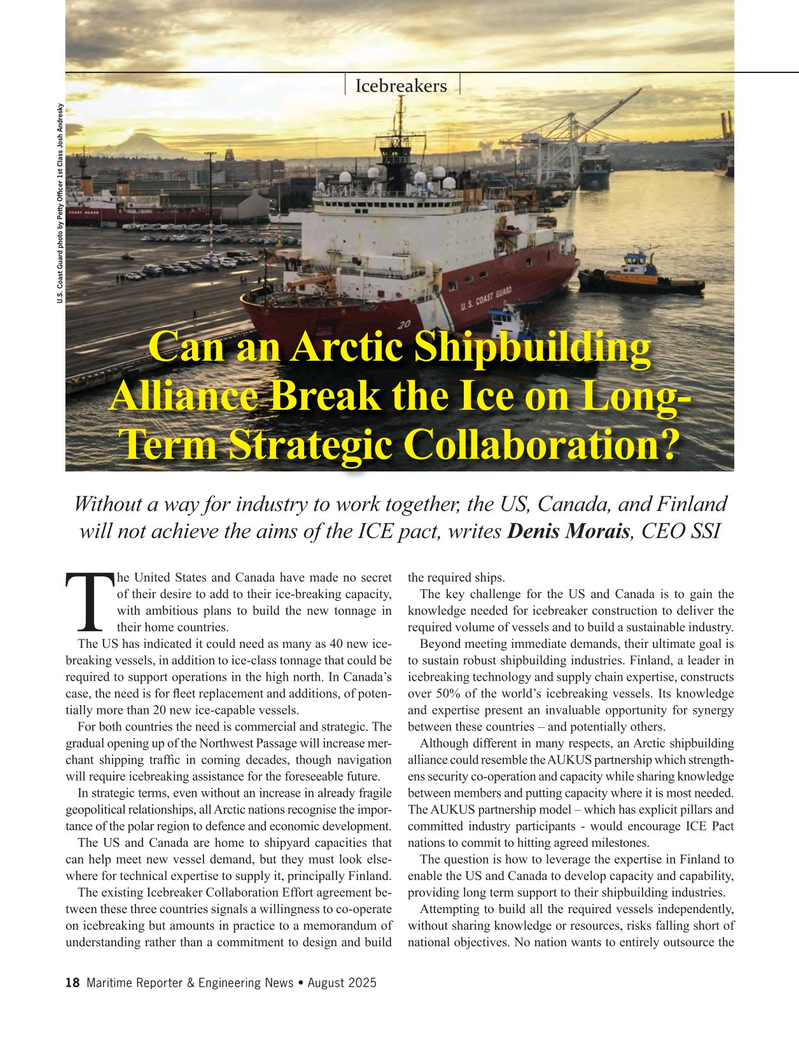
Page 18: of Maritime Reporter Magazine (August 2025)
Read this page in Pdf, Flash or Html5 edition of August 2025 Maritime Reporter Magazine
Icebreakers
U.S. Coast Guard photo by Petty Of? cer 1st Class Josh Andresky
Can an Arctic Shipbuilding
Alliance Break the Ice on Long-
Term Strategic Collaboration?
Without a way for industry to work together, the US, Canada, and Finland will not achieve the aims of the ICE pact, writes Denis Morais, CEO SSI he United States and Canada have made no secret the required ships. of their desire to add to their ice-breaking capacity, The key challenge for the US and Canada is to gain the with ambitious plans to build the new tonnage in knowledge needed for icebreaker construction to deliver the
Ttheir home countries. required volume of vessels and to build a sustainable industry.
The US has indicated it could need as many as 40 new ice- Beyond meeting immediate demands, their ultimate goal is breaking vessels, in addition to ice-class tonnage that could be to sustain robust shipbuilding industries. Finland, a leader in required to support operations in the high north. In Canada’s icebreaking technology and supply chain expertise, constructs case, the need is for ? eet replacement and additions, of poten- over 50% of the world’s icebreaking vessels. Its knowledge tially more than 20 new ice-capable vessels. and expertise present an invaluable opportunity for synergy
For both countries the need is commercial and strategic. The between these countries – and potentially others. gradual opening up of the Northwest Passage will increase mer- Although different in many respects, an Arctic shipbuilding chant shipping traf? c in coming decades, though navigation alliance could resemble the AUKUS partnership which strength- will require icebreaking assistance for the foreseeable future. ens security co-operation and capacity while sharing knowledge
In strategic terms, even without an increase in already fragile between members and putting capacity where it is most needed. geopolitical relationships, all Arctic nations recognise the impor- The AUKUS partnership model – which has explicit pillars and tance of the polar region to defence and economic development. committed industry participants - would encourage ICE Pact
The US and Canada are home to shipyard capacities that nations to commit to hitting agreed milestones.
can help meet new vessel demand, but they must look else- The question is how to leverage the expertise in Finland to where for technical expertise to supply it, principally Finland. enable the US and Canada to develop capacity and capability,
The existing Icebreaker Collaboration Effort agreement be- providing long term support to their shipbuilding industries.
tween these three countries signals a willingness to co-operate Attempting to build all the required vessels independently, on icebreaking but amounts in practice to a memorandum of without sharing knowledge or resources, risks falling short of understanding rather than a commitment to design and build national objectives. No nation wants to entirely outsource the 18 Maritime Reporter & Engineering News • August 2025
MR #8 (18-33).indd 18 MR #8 (18-33).indd 18 8/1/2025 5:16:40 PM8/1/2025 5:16:40 PM

 17
17

 19
19
